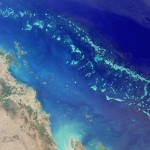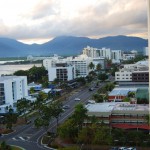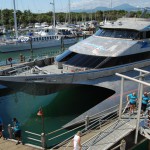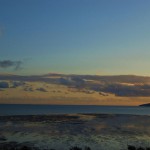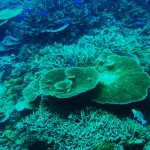Great Barrier Reef
The second stop of my journey in Australia was the Great Barrier Reef. Around four hours by plane from the Uluru-Kata Tjuta National Park took us to the capital of the Great Barrier Reef, the city of Cairns.
Cairns is built on the Coral Sea’s coast in the tropical zone of the north-east Australia. The climate in this part of Australia is warm and humid; therefore, the city of Cairns drowns in foliage. Tropical forest surrounds the city on all sides, and Cairns’ citizens from time to time have to fight “green invaders,” clearing the streets of lianas and brushwood.
We had planned a supper in one of the restaurants, which was 20 minutes away by car from the hotel. The road to the restaurant resembled an excursion at the zoo. Our way was blocked from time to time by geckos and lizards, different bugs and insects, spiders and Australian ibises, which are as common in Australia, as pigeons in our country. The evening air was filled with aromas of blossoming bushes and trees, and with various sounds, made by birds, bats, and flying foxes, along with the noise from insects.
Early the next morning, our guide came to pick us up, and we went to Port Douglas where a catamaran was waiting for us. By catamaran we got deep into the Great Barrier Reef, 60 kilometers off the coast, and during the whole day we enjoyed the beauty of coral “woods” and their inhabitants.
The Great Barrier Reef is a range of coral reefs and islands in the Coral Sea, stretching along the north-east coast of Australia for 2,300 kilometers. In its north section, its width is around 2 kilometers, while in the south it is 150 kilometers. Most of the reefs are under water (they surface during low tides). The Sea National Park (its area is over 5 million hectares; being established in 1979, it is now included into the World’s Heritage List) preserves the flora and fauna of the shallow coastal waters.
The islands of the Great Barrier Reef are for a reason called the eighth world wonder. Many beautiful islands with splendid beaches, scenic landscapes and crystal clear water are known in the world. But the Great Barrier Reef is the biggest reef system in the world and the largest structure, which is “created” by living organisms of the planet. Among 350 species of corals known in the world, 340 are on the islands of the Great Barrier Reef. The necklace of islands stretches for 2,000 kilometers from Papua New Guinea to the South Tropic in the south.
The Great Barrier Reef includes close to 2,900 reefs, which sizes vary from 0.01 sq. kilometers to 100 sq. kilometers and more than 300 islands or sandbanks consisting of coral pieces, 100 of which are always covered with green growth; and 600 more highland islands, many of which are surrounded by their own reefs. Its general area is 348,698 sq. kilometers, which is more than that of Great Britain.
The Reef, which in itself is one of the largest geological formations, is actually built of living creatures, or coral polyps that are similar to actiniae in appearance and can be seen near the coast. These tiny primitive organisms live in huge colonies; and each one of them developed from a single polyp that divided itself countless number of times. The coral consists of a soft body, enclosed in a lime external shell, which directly forms the reef. A living reef is a product of a thousand-year life and death cycle: the main part of a coral reef is built of a huge mass of empty shells of the previous generations of polyps, covered by a thin layer of living organisms.
Coral reefs can live in water, the temperature of which is stable throughout the year within the range 22-28С; this creates the habitat for the most varied community of animals known on planet Earth. The Great Barrier Reef is formed by more than 400 species of hard and soft corals. Hard-shelled reef-forming corals may be of various forms and sizes and include mushroom-like corals, brain corals and corals-antlers of all colours from red and yellow to black. Besides, there are more than 4,000 species of mollusks found here: from chitons and gastropods to giant scallops and octopuses, as well as numerous sponges, actiniae, worms, crustaceans and echinoderms.
Coral reefs throughout the world are known for their variety of fish that come there. It is established that within the Great Barrier Reef and around it more than 1,500 kinds of fish dwell – one sees a kaleidoscope of colours and patterns, as they rush in packs to and fro. The reef is also crucial for several types of whales, including minke whales, killer whales and humpback whales. These waters are the territory of reproduction of hump-back whales; cows and their calves are often observed here. These waters also provide home for six of seven existing species of sea turtles; they are becoming extinct and they need uninhabited islands of the reefs for secure breeding of their offspring. Mysterious dugong also found a safe refuge in the jungle of seaweeds that is common in shallow waters near many of the islands of the reef.
The islands are crucial for many species of water- and seabirds. More than 240 species build their nests on low sandbank and coral islands; among them there are mutton birds, tropicbirds, frigatebird, six kinds of terns, including roseate tern, and fulmar, white-bellied sea eagle and fish-hawk.
This article uses the material from web resource: http://www.naturelifepark.com

